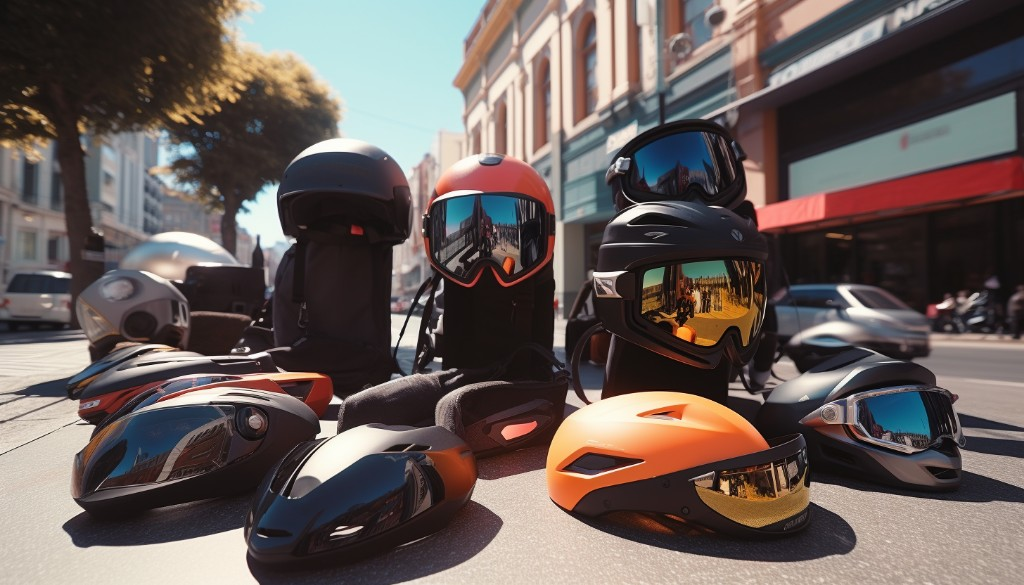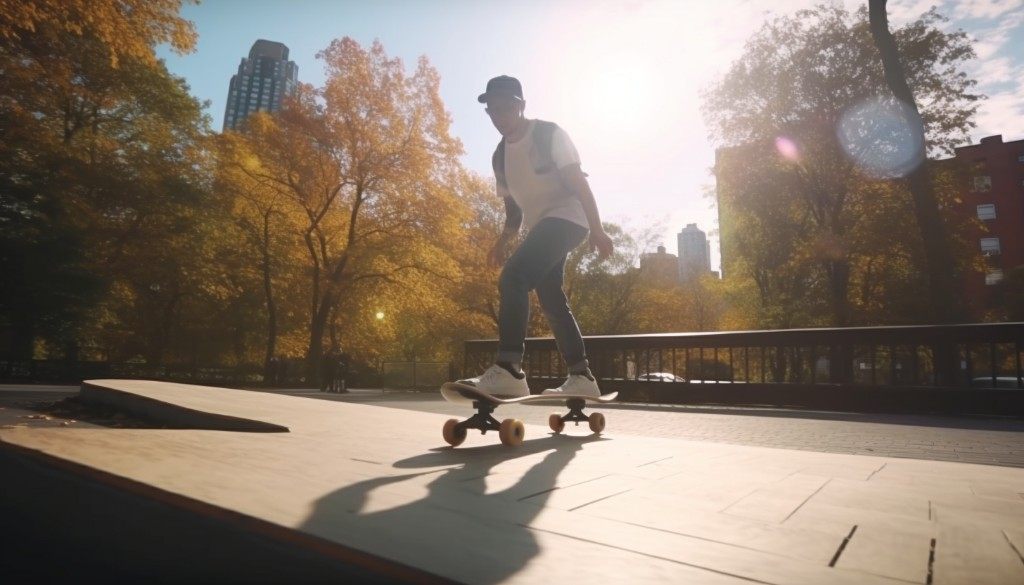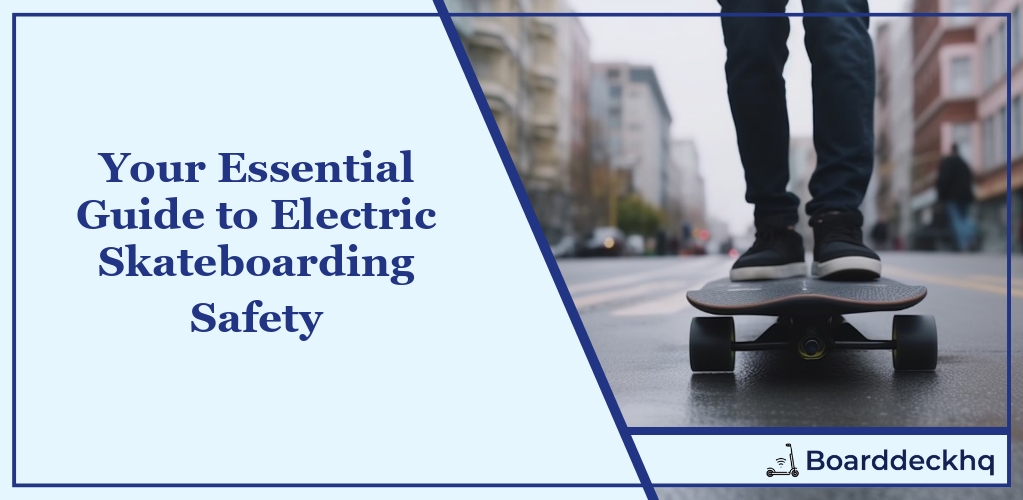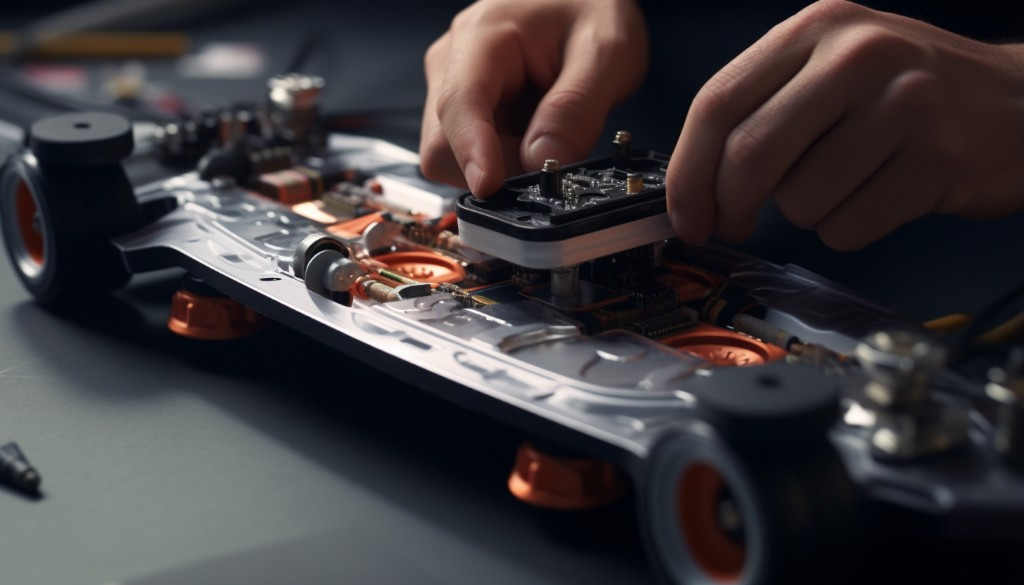As the sun sets, imagine yourself gliding smoothly on an open road, commanding the wind to move with every sway of your body – such is the allure of electric skateboarding! But it’s not all just thrill and freedom; electric skateboarding also brings with it significant responsibilities. Navigating the path safely is a matter of understanding the risks, equipping yourself with essential gear, practicing safe riding techniques, and getting to grips with maintenance tasks. In addition, knowing the rules and regulations, building your skills, and being prepared for nighttime or adverse weather conditions all play a part. So does being ready to handle any malfunctions and knowing what to do in case of accidents. Now let’s dive deeper into this comprehensive guide to electric skateboarding safety guidelines.
What we’ll cover:
- Electric Skateboarding Risks
- Essential Safety Gear
- Riding Safely
- Maintaining Your E-Skateboard
- Rules and Etiquettes
- Safer E-Skateboarding Training
- Nighttime E-Skateboarding Precautions
- Weather Conditions and Safety
- Dealing with E-Skateboard Malfunctions
- Emergency Response for Accidents
- Safety Apps and Devices
Ready for an exhilarating ride into the world of electric skateboarding safety? Let’s jump in, and convince you why safety should always be your top priority when you’re on that board!
Understanding Electric Skateboarding and Its Risks
Electric skateboarding is swiftly becoming a popular mode of transport for many, offering a unique blend of convenience and excitement. Yet, along with its rising popularity comes a corresponding rise in risks and accidents, which is why it’s critical to understand how electric skateboard accidents happen.
According to a study done by the U.S. National Library of Medicine, injuries from electric skateboard accidents have nearly doubled from 2004 to 2018, highlighting the potential dangers inherent in this activity. Common injuries include fractures, dislocations, and even traumatic brain injuries. Most of these accidents occur due to loss of control, high speeds, and/or collisions with motor vehicles or pedestrians.

So, how can you stay safe while riding an electric skateboard? One approach is by ensuring you’re well-equipped with the right protective gear and adhering strictly to safe riding practices.
Essential Safety Gear for Electric Skateboarding
When it comes to electric skateboarding, safety is paramount. Following some simple steps will ensure you stay safe while riding your electric skateboard. For example, never underestimate the power of dressing appropriately. Wearing proper safety gear can spell the difference between a minor scrape and a severe injury in an unfortunate fall.
Start with the most crucial piece: the helmet. Wearing a helmet when riding can significantly reduce the risk of severe head injuries. It’s not only about wearing any helmet, though; it should be a certified helmet designed to withstand impacts typical in skateboarding accidents. Wear a helmet every time you ride, even on short trips.
Next up are the knee and elbow pads. These pieces of protective gear are essential in shielding your joints from potential falls or collisions. Wrist guards also play a crucial role; they can save you from painful wrist fractures or sprains if you take an unexpected tumble.
Consider investing in a complete safety set consisting of a helmet, knee pads, elbow pads, and wrist guards. This comprehensive approach ensures maximum protection during your ride.

Safe Practices While Riding an Electric Skateboard
Knowing how to manage your speed on an electric skateboard is vital. Remember to always ride at a safe speed that allows you to react quickly to unexpected obstacles or changes in your path.
Being aware of your surroundings is another essential aspect of safe riding practices. This means not only watching out for traffic signs and signals but also being cognizant of pedestrians, cyclists, animals, or anything else that might cross your path unexpectedly.
Above all, it’s crucial to respect and follow traffic rules designed for the safety of everyone on the road. Not only does this mean obeying stop signs and traffic lights, but it also involves yielding to pedestrians and staying in designated lanes.
In essence, with the right protective gear and safe riding habits, you can enjoy the thrill of electric skateboarding while minimizing any potential risks. Always remember: safety first!
The Importance of Regular Electric Skateboard Maintenance
Owning an electric skateboard is just the beginning. To ensure you have an enjoyable and accident-free ride every time you ride, regular maintenance of your electric skateboard is key. So, what should you be looking at during a regular skateboard check-up?
Battery Safety and Maintenance
The lifeblood of your electric skateboard is its battery. Maintaining the battery of your electric skateboard not only extends its lifespan but also ensures it performs optimally. Always make sure your battery is fully charged before setting off; this is crucial because a half-charged battery might leave you stranded halfway through your ride.
Besides that, it’s also important to check for any signs of wear or damage. If there are any signs of swelling, leaks or physical damage, refrain from using the board until it’s been properly examined and repaired by a professional.
Never forget, proper battery maintenance of your electric skateboard isn’t just about performance; it’s also a matter of safety. A poorly maintained battery can lead to accidents, or worse, fires.
Preventing Accidents Through Maintenance
Regular checks on your board are not just about preserving your ride; they’re also about ensuring your safety. Loose bearings, worn-out wheels, or faulty brakes can lead to catastrophic accidents. So, next time before you ride your electric skateboard, spare a few minutes to check your board.
Optimal Performance
Regular maintenance ensures every ride is as good as the first one. It helps identify potential issues early on and keeps the performance of your skateboard at its peak.

Rules, Regulations and Etiquettes for Electric Skateboarding
Just like traditional skateboarding, electric skateboarding also has its own set of rules, regulations, and etiquettes that every rider should be aware of.
Understanding E-Skateboarding Laws
Before hopping onto your board, it’s important to understand the laws regulating electric skateboarding in your area. Some places require helmets and other safety gear, while others might restrict riding in certain areas or during certain hours.
Road Safety Guidelines
Following road safety guidelines is a significant part of electric skateboard safety when navigating traffic. This includes obeying traffic laws, staying within speed limits, using lights and reflectors when riding at night, and always maintaining a safe distance from pedestrians and other vehicles.
Pedestrian Etiquette for Electric Skateboarders
A critical aspect of electric skateboarding is respecting pedestrians. Always yield to pedestrians, use the board’s bell or your voice to signal your approach, and slow down in crowded areas.
Adhering to these rules and guidelines is important to maintain electric skateboard safety and to ensure an enjoyable ride for all.

Training and Skill Building for Safer E-Skateboarding
Whether you’re a beginner or an experienced skater looking to transition into e-skateboarding, training for electric skateboard users is essential.
The Importance of Training for Beginners
E-Skateboarding might seem simple but it requires skill and control. Beginners need to spend time learning the basics before hitting the streets. This includes understanding how to balance on the skateboard, how to steer, brake, and accelerate. A few practice sessions in a safe environment can make the transition much easier and provide you with a confidence boost.
Improving Skills
Even experienced riders can benefit from skill-building sessions. This could involve practicing tighter turns, riding at higher speeds with control or mastering the proper stance for electric skateboard safety. Many riders also delve into the world of electric skateboard tricks for beginners, before moving on to more advanced tricks and complex stunts as their skills progress.
Understanding the Controls
E-Skateboards come with handheld remotes that control speed and braking. Familiarizing yourself with these controls increases your ability to react quickly in unanticipated situations and protect yourself and others,

Precautions for Nighttime Electric Skateboarding
Getting a thrill from nighttime electric skateboarding is a fun and exciting way to explore the city. However, it’s essential to keep safety at the forefront of your adventures. One of the primary risks of riding at night is the lack of visibility, which could lead to accidents.
Enhance Your Visibility
Visibility and electric skateboarding safety are intertwined. To enhance your visibility:
- Wear brightly colored clothing so that motorists can see you..
- Use reflective gear like jackets, helmets, gloves, and shoes
- Attach lights on your skateboard and helmet.
Understand Your Surroundings
Understanding your surroundings is another aspect of nighttime electric skateboarding safety. Familiarize yourself with the terrain, avoid dark alleys or less-traveled paths, and always watch out for unexpected obstructions.

Weather Conditions and Their Impact on E-Skateboarding Safety
Weather conditions and electric skateboarding significantly influence each other. Changes in weather can affect the surface you’re riding on, and therefore, your safety.
Riding in Rain
Riding an electric skateboard in rain requires extra caution due to slippery surfaces. Here are some tips for safe riding in wet weather:
- Slow down to prevent sliding.
- Avoid puddles to prevent water damage to your board.
- Use rainproof gear for added safety.
Riding on Rough Surfaces
Riding an electric skateboard on rough surfaces can be challenging due to unstable footing and increased vibration. To handle this:
- Keep a low stance for better balance.
- Loosen your muscles to absorb shocks.
- Choose wider wheels for better grip.
Managing Electric Skateboard Malfunctions
Handling electric skateboard malfunctions is part of maintaining electric skateboard safety measures. Sometimes, malfunctions are unavoidable, but knowing how to handle them can prevent accidents.
Battery Issues
Battery issues are common malfunctions in E-Skateboards; they can result in sudden stops or slow performance. If you notice any unusual behavior related to battery performance, stop riding and check your battery connections and charge levels.
Brake Failures
Brake failures can be dangerous, especially at high speeds or downhill rides. Always check your brakes before each ride and consult a professional if any repairs are required.
Motor Problems
Motor problems can also compromise your safety when riding an electric skateboard. Signs of a failing motor include unusual noises or decreased performance. If you encounter any of these issues, stop riding and have your board checked by a professional.
Remember, taking precautions and being prepared for various situations is key to enjoying a safe electric skateboarding experience.

First Aid and Emergency Response for E-Skateboarding Accidents
When you take to the streets on your electric skateboard, you’re entering a world of exhilarating speed and manoeuvrability, but with this comes the risk of injury. Being prepared can make all the difference in the outcome of an accident. Knowing first aid for electric skateboard accidents can thus be a lifesaver in literal terms. So, if you’re unable to prevent an accident on your electric skateboard, take note of the following tips to ensure you know how to respond during an incident.
After an accident, the first thing to consider is your safety. Are you in a safe place? Can you move to a safer location? If you’re still in harm’s way, for example in the middle of a busy road, try to move to safety if possible.
First Aid Steps
Here are some basic first aid steps to consider:
- If you’re severely hurt, call for help immediately.
- Check if you’re bleeding. If yes, apply pressure to the wound with a clean cloth to stop the bleeding.
- If a bone appears to be broken or dislocated, try not to move it.
- If you’ve hit your head and feel dizzy or disoriented, it could be a concussion.
The risk of injury in E-Skateboarding is real, and sometimes the injuries can be more serious than they seem. Therefore, it’s crucial not to underestimate the impact of a fall or collision and seek medical help if appropriate.
When to seek medical help
Not all injuries require a trip to the emergency room, but some definitely do. Here are some cases when you should seek medical help:
- If there’s severe pain or you suspect a bone may be broken.
- If there’s heavy bleeding that won’t stop.
- If you’ve hit your head and have symptoms like dizziness, disorientation, or vomiting.
- If you’re having difficulty breathing.
Remember, when it comes to the risk of injury from E-Skateboarding, it’s always better to be safe than sorry.

Electric Skateboarding Safety Apps and Devices
In this digital age, technology has permeated every aspect of our lives, including safety while E-Skateboarding. Several electric skateboard safety apps and devices exist that can help reduce the risk factor while cruising on your board.
Role of Technology in E-Skateboard Safety
With advancements in technology, electric skateboarding has become not just more enjoyable but also safer. Here are some ways in which technology has contributed to safety:
- Apps can track your speed and notify you if you’re going too fast.
- Some apps have emergency contact features that send an alert if you’ve been in an accident.
- Newer E-Skateboards come with remote control enabling better control over your speed and movements.
Popular Safety Apps, Devices and Features
Here are some popular additions that can enhance your safety while E-Skateboarding:
Ride: ESK8 App
This app is designed specifically for electric skateboarding. It tracks your ride; including distance travelled, average speed, top speed, and map route, so that you can monitor your skateboarding progression.
ShredLights
These are powerful headlights and tail lights designed for skateboards. ShredLights make you visible to others on the road and improve your visibility, helping to keep you safe.
Lazy Rolling Armored Clothing
This is clothing designed with protective padding, which looks like regular streetwear but also protects you in case of a fall.
One requirement for safe electric skateboarding is maintaining safe distances from vehicles and pedestrians. Interestingly, some apps actually alert you when you’re too close to an object or person, signalling that you need to maintain a safe distance to avoid a collision.

Closing Thoughts
Electric skateboarding carries a unique set of risks, making it crucial to have a clear understanding of its operational nuances before embarking on any ride. Equipping oneself with essential safety gear forms an integral part of being prepared and ensuring safe practices are followed while on the skateboard. Regular maintenance of an electric skateboard not only enhances its performance but also mitigates potential risks. Moreover, following rules, regulations and etiquette are non-negotiable, aiding to maintain a safe environment for all. Training and skill-building in E-Skateboarding form the backbone of safety, honing the rider’s reflexes and response in tricky situations, which helps avoid a negative outcome. Nighttime electric skateboarding necessitates additional precautions for visibility and safety, and weather conditions heavily influence the safety dynamics of E-Skateboarding. In addition, understanding potential electric skateboard malfunctions and how to manage them can be life-saving. If the worst does happen, then knowledge of basic first aid and emergency response for E-Skateboarding accidents empowers a rider to handle unforeseen situations. Lastly, integrating safety apps and devices can fortify one’s defense against mishaps, making the E-Skateboarding experience safer and more enjoyable.
Frequently Asked Questions
What kind of protective gear is recommended for riding an electric skateboard?
Recommended protective gear for riding an electric skateboard includes a well-fitting helmet, knee and elbow pads, wrist guards, and durable footwear. Some riders also wear padded jackets or shorts for additional protection.
How often should I check my electric skateboard’s battery?
It is advisable to check your electric skateboard’s battery before each ride to ensure it has sufficient charge. Regularly inspect the battery health every few months to detect any potential issues early.
Are there specific rules I need to follow when riding an electric skateboard?
Yes, specific rules for riding an electric skateboard vary by location but generally include riding at safe speeds, yielding to pedestrians, and using lights or reflectors at night,.
Which brands offer the best safety features in their E-Skateboards?
Several brands prioritize safety in their E-Skateboards, including Boosted Boards, Evolve Skateboards, and Inboard. These brands incorporate features like regenerative braking, lights for visibility, and robust construction.
Is it safe to ride an electric skateboard at night?
Riding an electric skateboard at night can be safe if proper precautions are taken. This includes wearing reflective clothing, using front and rear lights on your board, and sticking to well-lit areas where possible.


